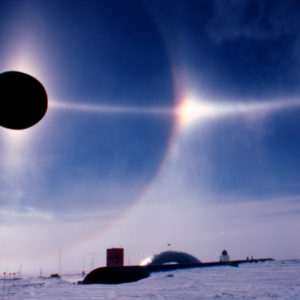 The shadows on these short days of winter are long and all encompassing. Sunlight glints off the surface of the crystalline snow, blinding us literally and figuratively with its brilliance. Even the atmosphere seems awash with light and color, as the combination of sunlight and ice creates all kinds of visual effects, crafting a scenic beauty that really can’t be felt any other time of the year.
The shadows on these short days of winter are long and all encompassing. Sunlight glints off the surface of the crystalline snow, blinding us literally and figuratively with its brilliance. Even the atmosphere seems awash with light and color, as the combination of sunlight and ice creates all kinds of visual effects, crafting a scenic beauty that really can’t be felt any other time of the year.
We’ve all played with prisms, holding them up to the light and watching them magically break the white light up into its constituent colors. Maybe you even have some dangling in your house or from your car mirror (which is actually dangerous if you’re ever in an accident), injecting color into your daily routine. And if you’ve ever closely examined a snow crystal, you might have marveled how the crystalline structure resembles those prisms, with straight angles and structures that seem to have a geometry all their own.
As you may remember from high school chemistry, water is not as ordinary as we might imagine. I won’t digress to the details of water molecule polarity, lest I lose some of you, but suffice it to say that subatomic forces within the water molecule create a particular angle (104.5°), which is organized most efficiently in the hexagonal structure we see in snowflakes and ice crystals. What this all means is that frozen water in our atmosphere is constantly forming and reforming beautiful, unique, crystals that interact with light to create some impressive displays.
Let’s move from chemistry class to physics, and I hope I didn’t lose anybody here, because this is where it really gets interesting. Light from the sun interacts with ice crystals, both on the ground and in the atmosphere, and it’s that magic combination of sunlight and water that conjures up the fleeting beauty that we see. Light hitting a surface can be reflected or refracted. When light is reflected, it is bounced back in its entirety, and we see it as white light because the light is not being bent or broken into its constituent wavelengths (colors). When light is refracted, however, it moves through the medium, instead of bouncing off, and the light is bent, causing it to break up into its individual colors. So when light hits an ice crystal, some of it is refracted, meaning it travels through the crystal, but it is also bent because of the change in speed, causing us to see the rainbow within.
But ice crystals are not just on the ground, they can be found almost anywhere, even floating in our atmosphere. And these floating ice crystals create all kinds of interesting visual effects that you’re probably familiar with, even if you don’t know their names. Perhaps you’ve seen a “halo,” which is a ring of light that forms around the sun or moon when their light refracts off of ice crystals in the atmosphere, usually a thin layer of cirrus clouds. These are usually seen as a bright, white ring around the sun or moon, although they can be colorful as well. Or maybe you’re more familiar with sundogs, which are colored arcs of light that develop in the sky from the refraction of sunlight through ice crystals. They are located approximately 22° either left or right from the sun (or both), and can look like miniature “suns” surrounding the true sun. And sometimes you can spot “sun pillars”, which appear as towers of light extending vertically from the sun, usually at sunrise or sundown. These develop as a result of ice crystals falling slowly through the atmosphere as the sun’s light is reflected off of them.
The interplay of light, shadow, and sun creates some amazing displays, inspiring artists and explorers alike. But to see them, you have to be out in it! (And don’t forget your sunglasses, because the reflection of intense sunlight in your eyes can cause snowblindness, which can feel like sand in your eyes if you don’t properly protect those peepers.) The science of snow, whether we understand it or not, is pretty phenomenal. And while you might not be inspired to dust off the old chemistry textbook, hopefully this will have inspired you to at least appreciate the delicate and precise chemistry that creates this beautiful world of ours.
Jaymee Squires is the Director of Graduate Programs at Walking Mountains Science Center in Avon. While she is not a big fan of the cold, she has learned to just bundle up so she can appreciate the beauty that winter has to offer.









